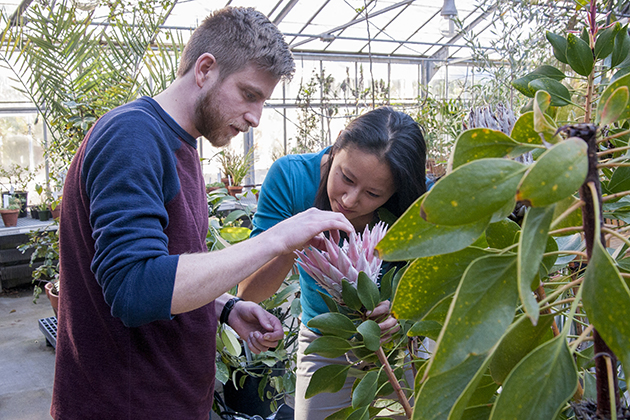
A study spearheaded by UConn graduate students has found that species of two plant families sharing the same habitat sometimes respond in different ways to key climate changes.
The findings suggest that trait diversity may be the result of individual responses to the environment, rather than – as is more commonly assumed – all plant species responding in a similar way to a specific environmental factor.
Appearing in the April issue of The American Naturalist, the research represents an advance in the understanding of the relationship between ecological and evolutionary processes. The findings may help shed light on the past evolution of plant characteristics in relation to environmental change, and what the future may hold for those plants.
Nora Mitchell and Timothy Moore, Ph.D. students in UConn’s Department of Ecology and Evolutionary Biology, co-authored the paper based on two important plant lineages in South Africa, Protea and Pelargonium. They used complex statistical analysis to evaluate the effects of key climate variables on multiple traits across the two families.
Sometimes Protea and Pelargonium exhibited similar characteristics in response to an environmental factor such as rainfall but not always, they said. These findings demonstrate that trait diversity within two plant lineages may reflect both parallel and idiosyncratic responses to the environment, rather than all conforming to a global-scale pattern.
Detailed observation in one of the world’s six floral kingdoms

To perform their study, Mitchell and Moore turned to a conservation area that is a biodiversity hotspot in South Africa. The region hugs the coastline along the far southwestern tip and is home to approximately 9,000 different plant species, many of which are found nowhere else in the world.
Both of the plant families studied flourish in the conservation area. It is home to about 70 species of Protea and 195 species of Pelargonium.
Plants in the Protea family range from low-growing shrubs with sprawling stems to small trees. Leaf size and shape varies markedly among the species and these differences are functionally significant. Pelargonium’s wide variety of species includes annuals, stem succulents, and both evergreen and deciduous small shrubs with wide leaf variations. Despite their differences, the two families occupy similar environments, and many grow in the same places.
Over a three-year period, the researchers measured more than 1,200 individual plants to study traits that are important to their survival, and also looked at how these traits responded to six different environmental variables.
“Beyond its sheer size, what sets this research apart is that we are looking at these plants as an integrated whole instead of doing what many previous studies have done which is to take one measurement or one particular characteristic and plot that against a single variable, such as rainfall,” said Moore.
The big picture: Evolution and climate change
Although the research is ongoing, one of the most significant conclusions from Mitchell and Moore’s study is that there are multiple strategies of evolutionary response to climate change, says Carl Schlichting, ecology and evolutionary biology professor and an investigator on the study.
“Nora and Tim and others working on this project are collecting data on a scale that hasn’t been done before,” he says. “They are challenging traditional assumptions of trait analysis.”
Schlichting adds that with sufficient data, researchers may be able to reconstruct how plant characteristics have changed over the past 15 million years.
“By comparing changes from a common ancestor we may gain a better understanding of how existing [plant] communities have developed in the face of changing climate conditions,” he says, “and maybe predict what we can expect in the future.”
The research is part of a $3 million grant awarded to UConn by the NSF as part of its Dimensions of Biodiversity program, a program that focuses on the intersection of genetic, phylogenetic, and functional dimensions of biodiversity. The long-term goal of the program is transforming our understanding of the scope and role of life on earth by the year 2020.



